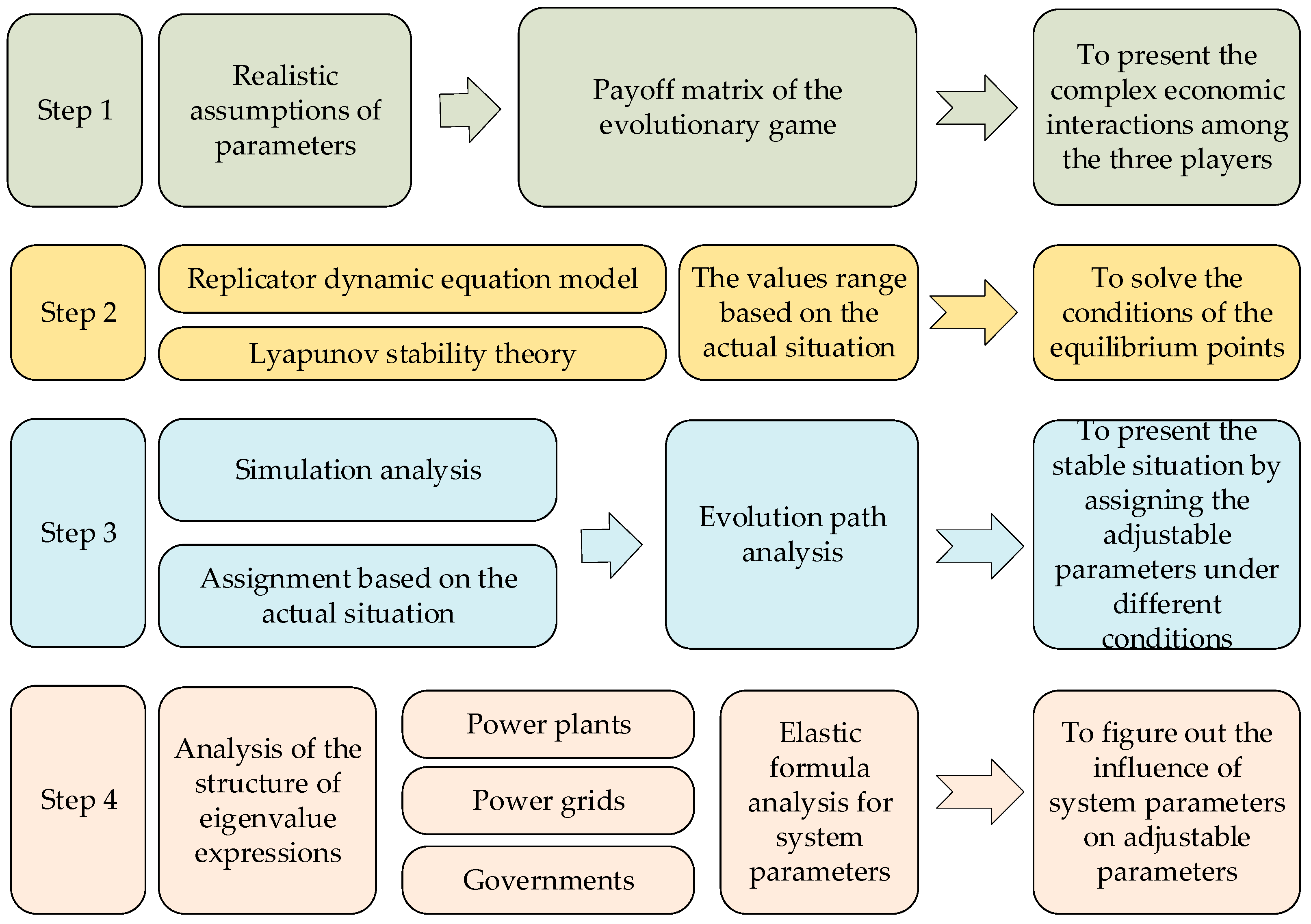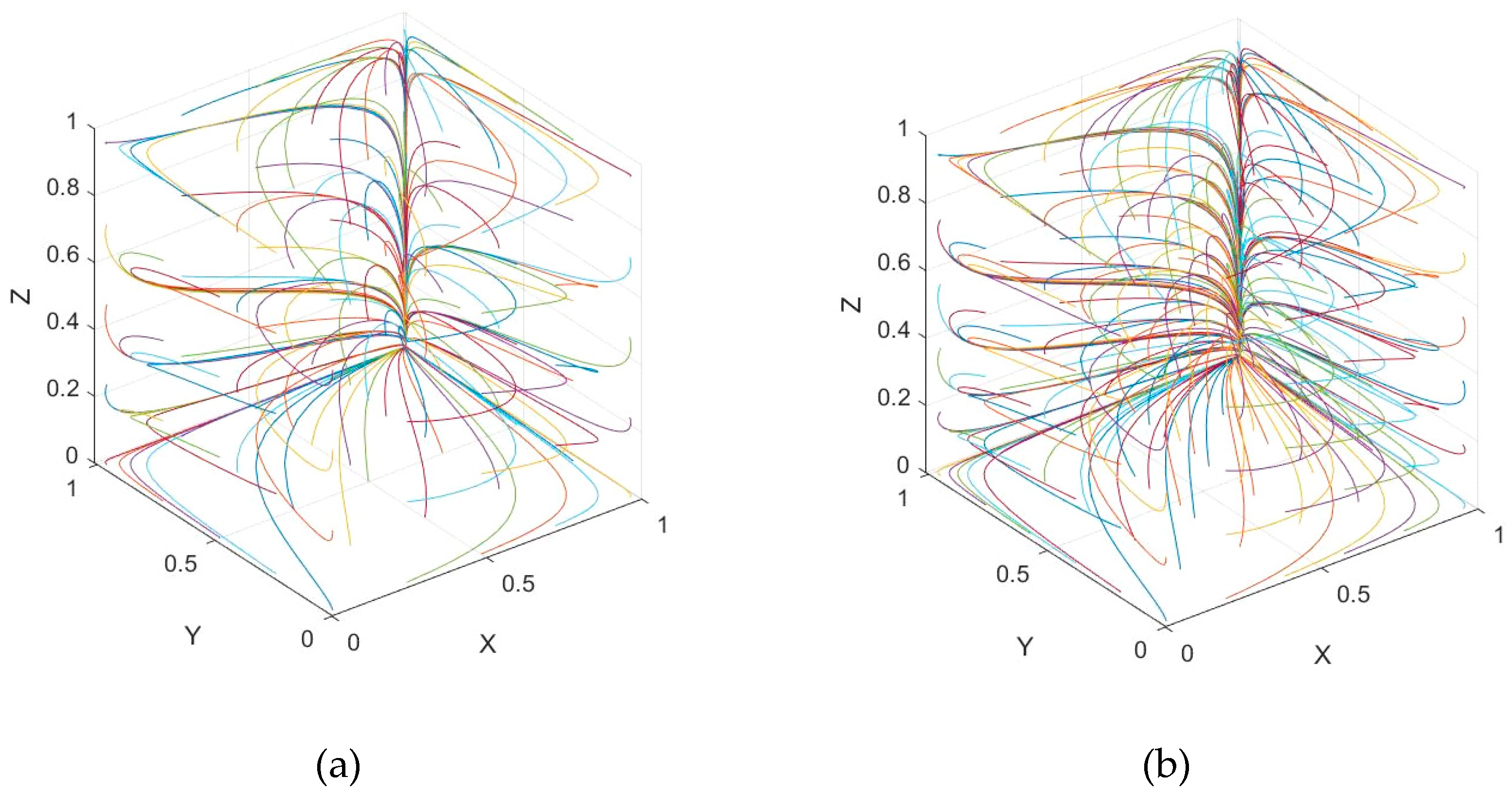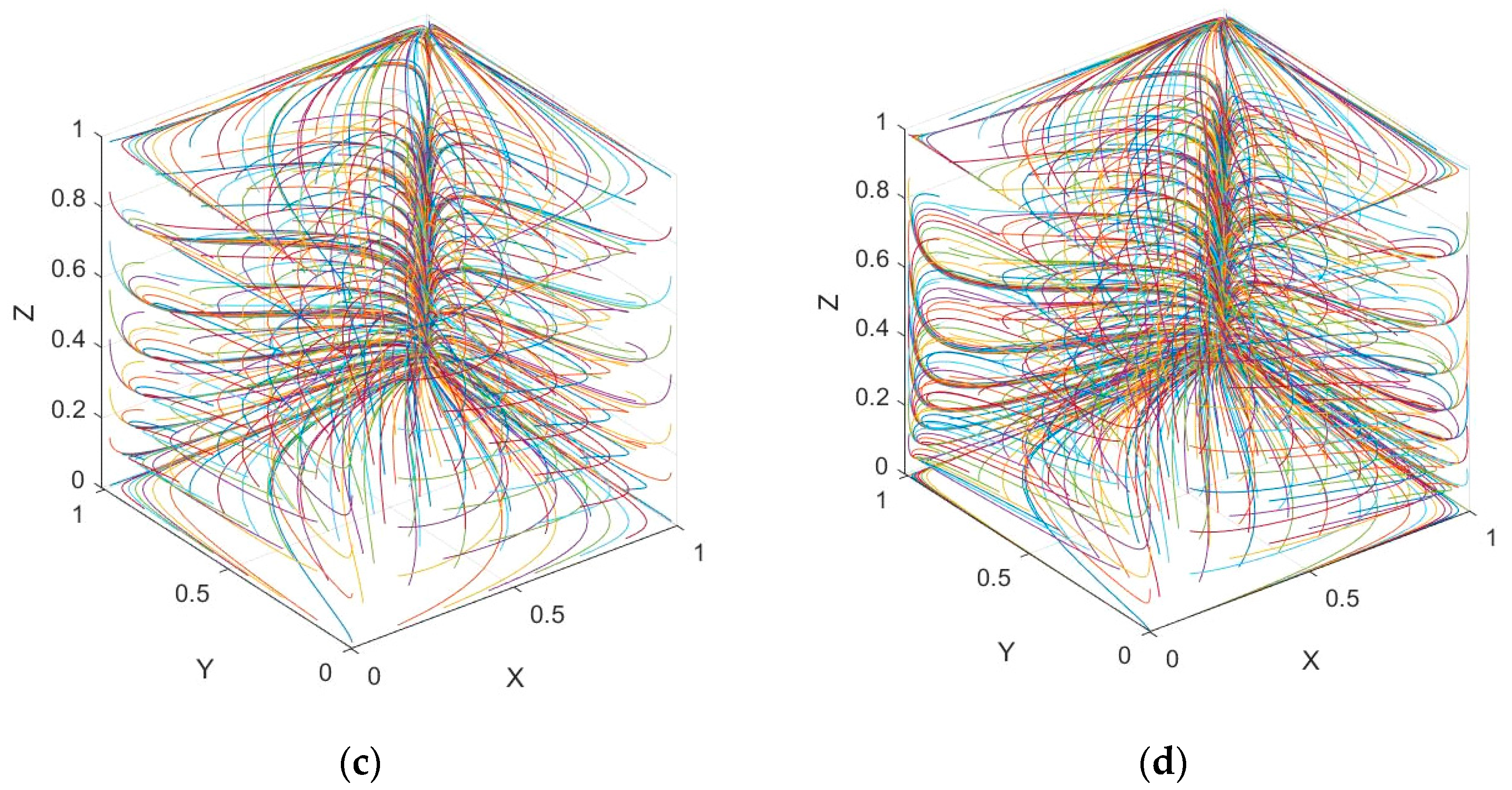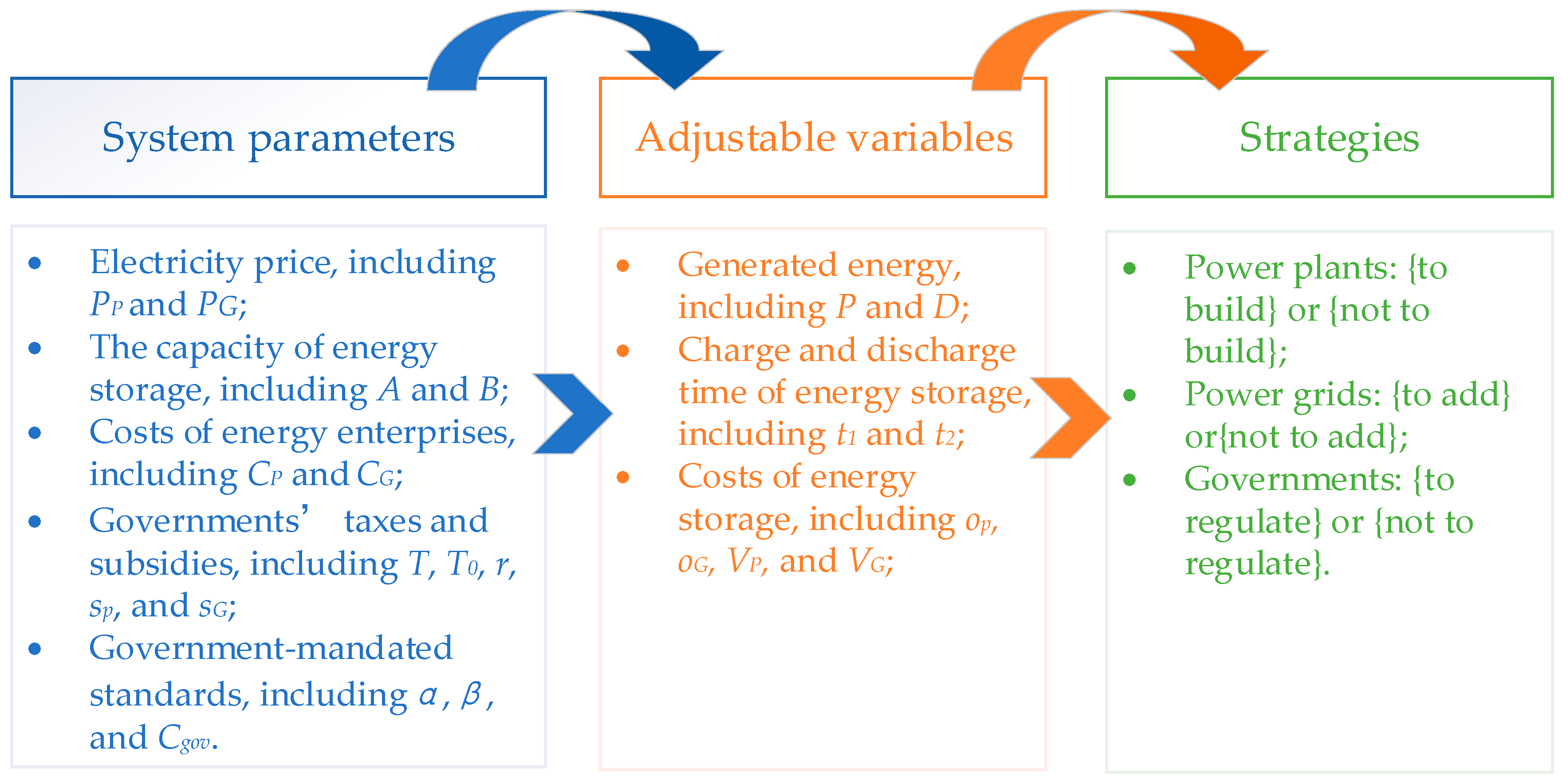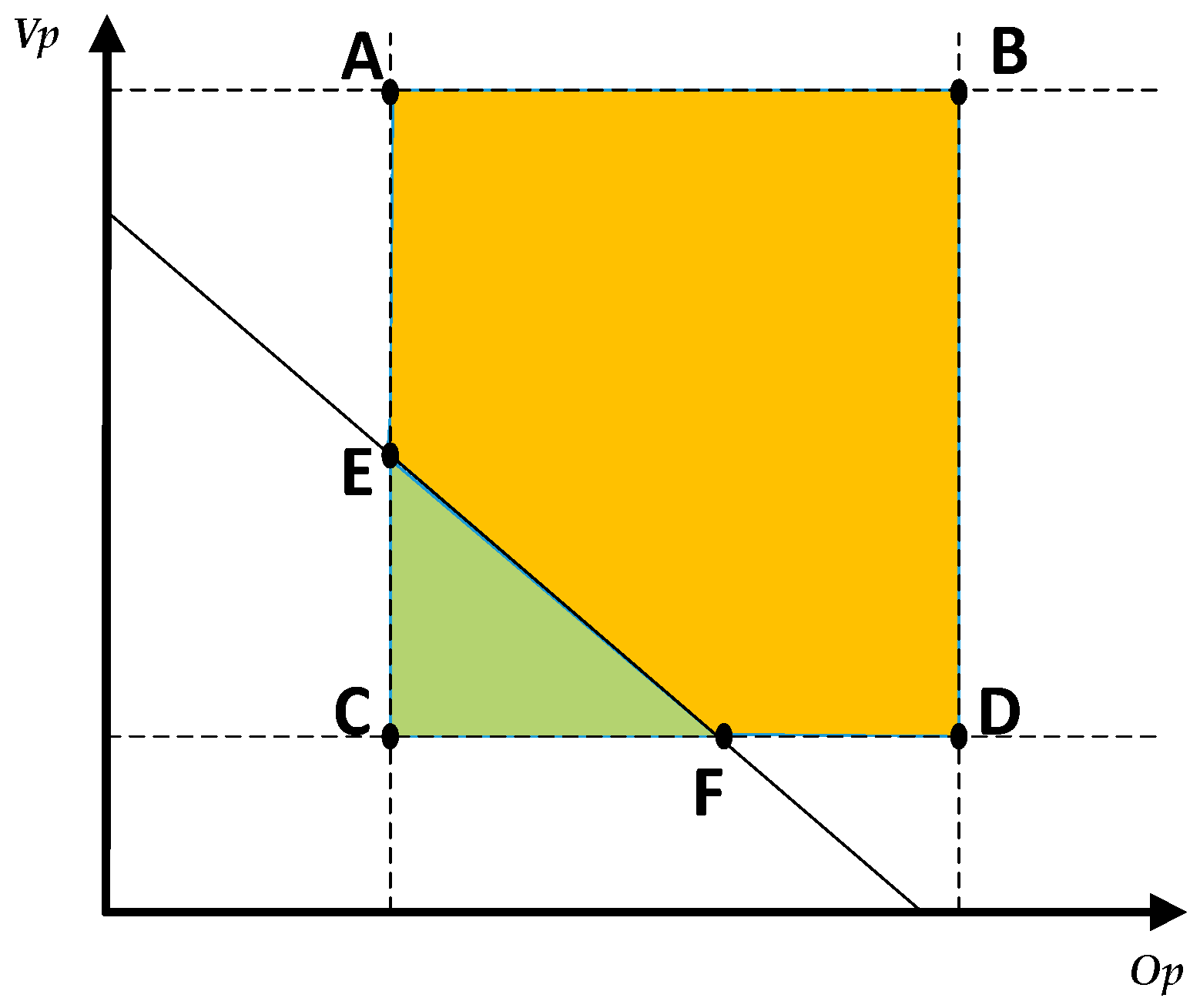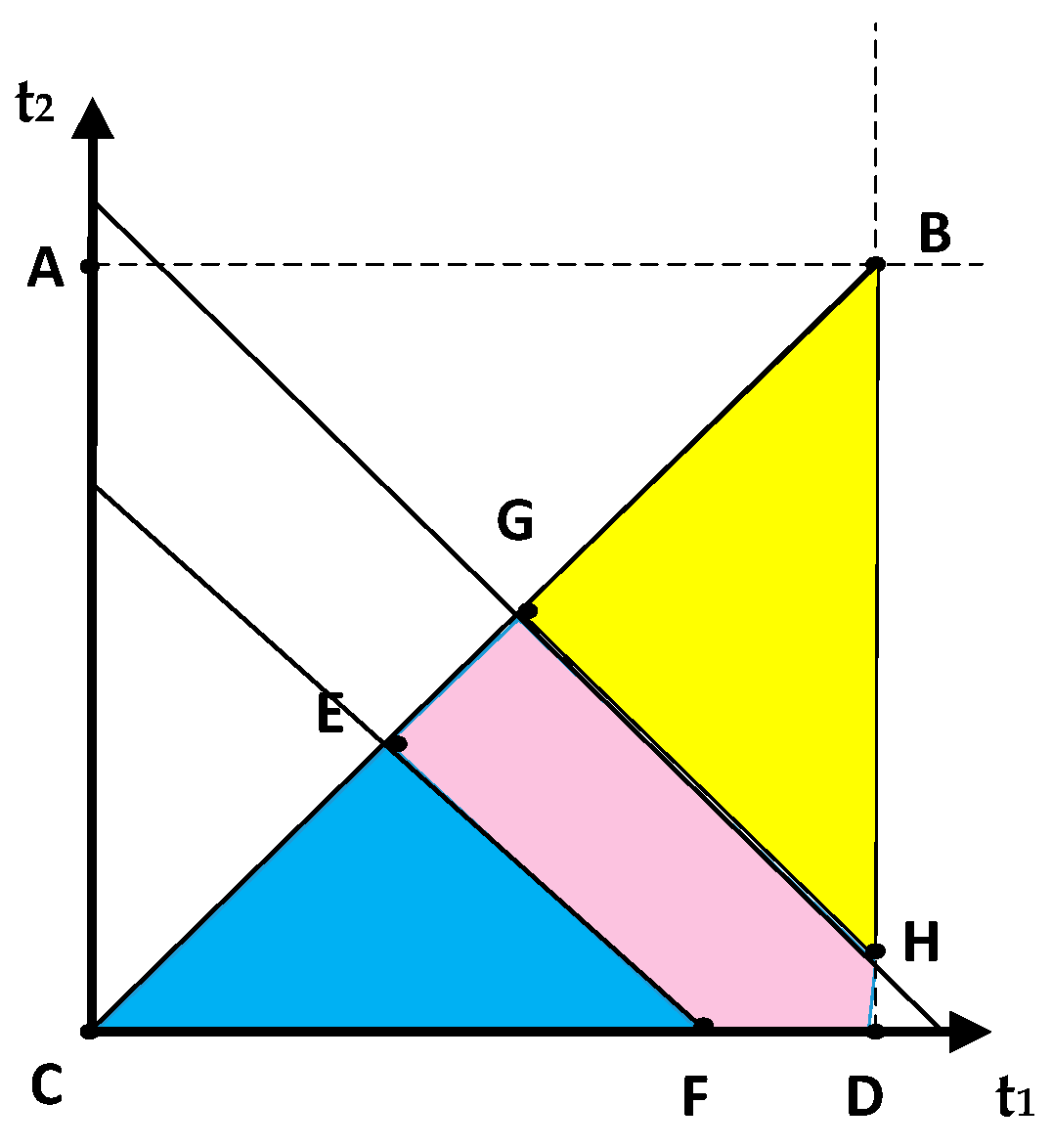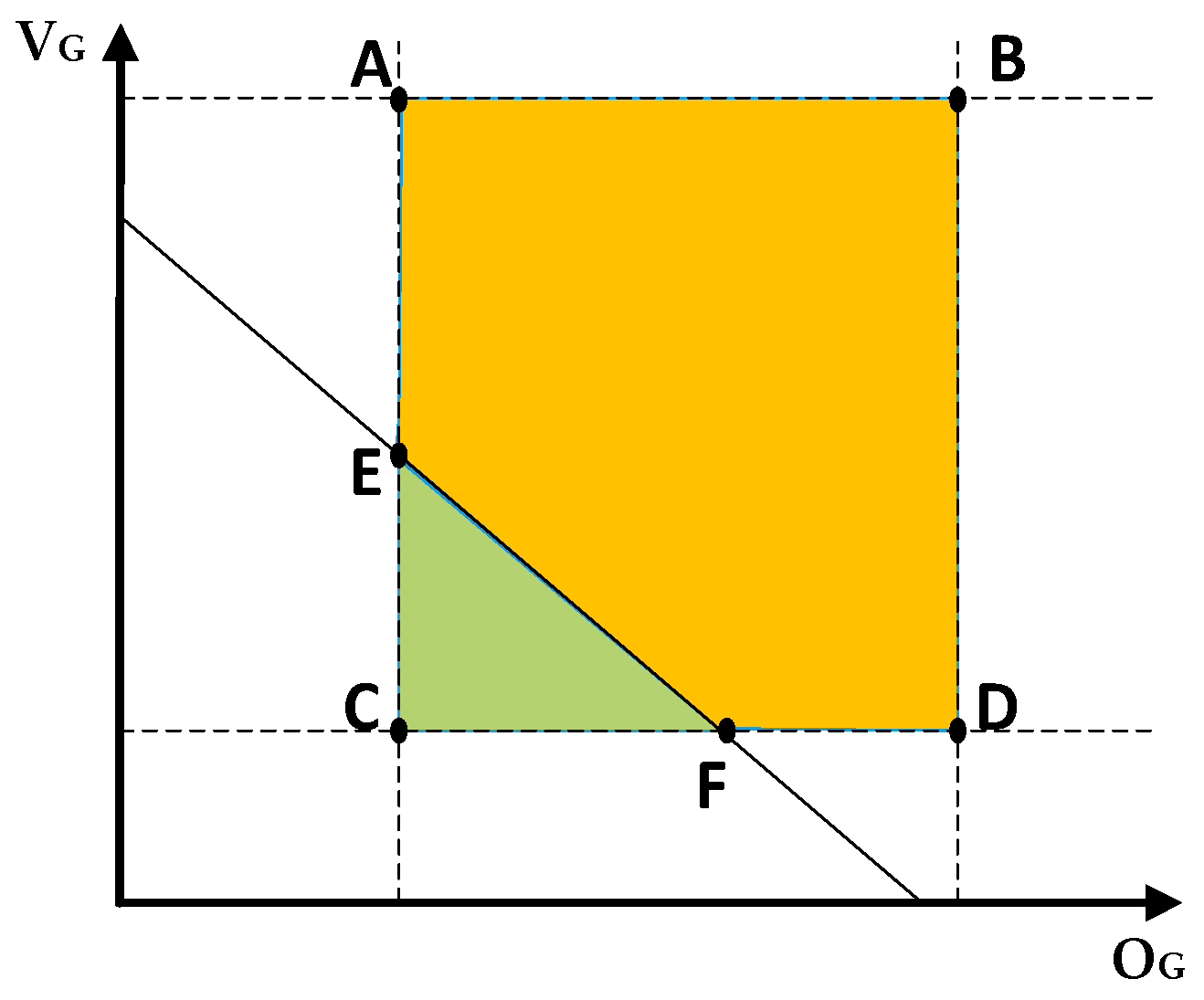The changes of the system parameters can then be calculated to analyze its impacts on the adjustable variables of the three players according to Equations (20)–(22).
4.2.1. The Influence of System Parameters of Power Plants on Adjustable Variables
To measure the impact of changes in feed-in tariff, variable costs, and carbon tax on the adjustable variables of power plants, we set sensibility indicators as per Equations (23)–(26)
At the equilibrium point (1,1,0), there is the conclusion of
according to Equation (23). This indicates that, if there is a small change in the on-grid price (
), the variable cost of the power plants (
), and the carbon tax (
),
would change substantially.
is influenced by the average daily electricity generation (
) and the energy storage per load (
). As shown in
Table A1, due to Equation (9)
the magnitude of changes in
, and
results in the same magnitude but opposite effects on the θ.
For example, when (yuan/kWH), that is (0.335, 0.465) (yuan/kWH), the medium-and small-scale power plants will eventually choose to build energy storage facilities. The lower is, the less profitable the power plant will be, and the more sensitive the medium-and small-scale power plants will be. Facing the energy storage facilities of the same specification, when is extreme low, only power plants of a medium-or-higher size will eventually choose to build energy storage.
When (yuan/kWH), that is is in the range of (0.25, 0.335) (yuan/kWH), the power plants ultimately choose not to build energy storage facilities. Since is less than 0 at this time, the deficit pressure will be heavier for the power plants with the burden of an energy storage cost. At this point, the loss of installing energy storage is relatively higher than that of not installing energy storage. Therefore, in order to avoid making the situation worse, power plants of all scales tend to choose not to build energy storage.
Similarly, when changes in the range of 0.135~0.265 (yuan/kWH), it has the same influence on the average daily power generation () due to the condition of (yuan/kWH). The larger is, the more sensitive P is. Because the rising cost of power generation will reduce the profits of medium- and small-scale power plants, they cannot afford energy storage projects of the same specification. When the government chooses to levy a carbon tax, it increases the cost burden of power plants, which has the same impact on as . When T varies within the range of (yuan/kWH), the power of the generator set in the power plants with energy storage is greater than 490 (MWH).
At the evolutionary stable equilibrium point (1,1,0), we can obtain the following conclusions based on Equations (24) and (25): and .
This indicates that the feed-in tariff (), the variable cost of the power plant (), and the carbon tax () have a significant impact on the energy storage cost of the power plants, including the construction cost () and operating cost ().
As shown in
Table 5 and
Table 6, the energy storage costs borne by power grid enterprises are operating costs and construction costs. The two costs satisfy the conditions of
(yuan/kWH) and
(yuan/kW). The corresponding points are shown in
Figure 5, including the points of A (0.05, 7), B (0.15, 7), C (0.05, 1.5), and D (0.15, 1.5). We set
equal to
. Point E and Point F are the intersections where the line EF intersects the sides of the rectangle ABDC. Line EF satisfy the equation of
. Point E is on the side of AB or AC, and Point F is on the side of DB or DC.
The detailed impacts of
on
and
are shown in
Table A2. As the
changes, the range of
and
changes.
Table A2 describes the changes in range by using the change in the coordinates of Point E and Point F. When
is in the range of (−0.085, 0.039) (yuan/kWH), the profits of the power plants are very low; thus, the energy storage technology on the market is unaffordable. After a long-term evolutionary game, the power plants choose not to build energy storage facilities, that is to achieve evolutionary stability at the point (0,1,0). Correspondingly, the point
is within the rectangle ACDB in
Figure 5. When
is in the range of 0.032~0.1306 (yuan/kWH) and
, the power plants choose to build energy storage facilities. In
Figure 5, this area corresponds to the point
within the scope of triangular ECF, which satisfies the evolutionary stable equilibrium condition of the point (1,1,0). On the contrary, the points in the range of polygon AEFDB satisfy the stable equilibrium condition of evolution at (0,1,0).
According to Equation (9), and have the same impact depth as but in the opposite direction on energy storage cost. When increased by 0.01 (yuan/kWH), the corresponding and increased by 0.72 (yuan/kW) and 0.045 (yuan/kWH) respectively. When the feed-in tariff is extremely low, the profit margins of the power plants are squeezed. When , power plants tend to choose the low-cost energy storage devices, such as lead carbon batteries. Faced with expensive energy storage technologies, power plants will choose not to build energy storage due to the cost burden. When (yuan/kWH), power plants have a wider choice of energy storage technologies on the basis of profitability. For example, power plants with greater profit margins could opt for more cost-effective lithium-ion batteries.
As shown in
Table 5 and
Table 6, energy storage charging and discharging time meets the basic conditions of
. The corresponding points A (
), B (12,12), C (0,0), and D (12,0) are shown in
Figure 6. Because the storage charging time must be longer than the discharge time, the corresponding range is inside the triangle BDC. Let
and
. Points E and F are the points where the line EF intersects the sides of the triangle BDC. The line EF satisfies the equation of
. In addition, the charging and discharging time of energy storage is also affected by the net profit. Points G and H are the points where the charge and discharge time constraint line GH related to
or
intersects the side of the triangle BDC. The line GH satisfies the equation of
. Points E and G are on the side of BC, and Points F and H are on the side of DB or DC. Point I is the intersection of line EF and line GH.
Based on Equation (26), we can obtain the conclusions of
and
. This means that the size of the net profit of the power plant has an impact on the choice of charging and discharging time for energy storage. When
increases by 0.01 (yuan/kWH), the charging and discharging time of energy storage will increase by 7.2 (h) correspondingly. This means that power grid companies are more willing to use energy storage facilities for longer periods if their profit margins increase. As shown in
Table A3, when the
is less than 0.055 (yuan/kWH), the charging and discharging time of energy storage greatly restricts the power plant from making profits. In other words, power plants will make the total charge and discharge time less than the average daily charge and discharge standard regulated by the government (
), which leads to subsidy cheating. When
is above 0.055 (yuan/kWH), power plants that choose to build energy storage facilities will have more charging and discharging time options. When the
of the power plants without subsidies can afford the energy storage construction cost, the power plant chooses to use energy storage in accordance with regulations, and the government ultimately chooses not to regulate it. When power plants need sufficient subsidies to cover the cost of energy storage, they are inclined to implement subsidy fraud. Facing widespread and serious subsidy fraud, the governments will ultimately choose to take regulatory measures.
4.2.2. The Influence of System Parameters of Power Grids on Adjustable Variables
For Equation (21), we assume the following sensibility indicators:
Based on Equation (27), we can obtain the conclusion of
. This is in line with the economic law of lower prices and higher demand. As shown in
Table A4, when
is within the range of
(yuan/kWH), power grid enterprises of all electricity demand levels will not choose to add energy storage equipment after a long-term evolutionary game. Given that the enterprises themselves are struggling to make ends meet, adding storage rashly would only make the situation worse. When
is in the range of
(yuan/kWH), power grids with small or even micro electricity demand from users will choose not to add energy storage devices. As the net profits
fall, the scales of the power grid enterprises must be increased to afford the store energy devices. When
is less than
, only the super-large-scale power grids enterprises can afford it. When
is in the range of
(yuan/kWH), the power grid enterprises with a medium-or-higher-scale electricity demand will choose to build energy storage after long-term evolution. As
rises, energy storage becomes affordable for some small or even micro power grid enterprises. We can conclude that, if the profit margins of the power grid enterprises shrink slightly, the electricity demand of power grid enterprises will largely increase.
Based on Equations (28) and (29), we can obtain the conclusions of and .
The energy storage costs of power grid enterprises include operating costs and construction costs. Based on the basic settings in
Figure 5, we set
equal to
. Points E and F are the intersections where the line intersects the sides of the rectangle ABDC, as shown in
Figure 7. The line EF satisfies the equation of
. With different values of
, the corresponding coordinates of Points E and F change, as shown in
Table A5.
When is within the range of (yuan/kWH), power grid enterprises have difficulty in making profits. Facing the energy storage cost of (yuan/kWH) and (yuan/kW), the power grid enterprises choose not to add energy storage facilities. When is within the range of (0.05149, 0.21) (yuan/kWH), the profits of power grid enterprises can cover several types of energy storage technologies. If the power grid enterprises can make profits after adding energy storage, the power grid enterprises ultimately choose to build energy storage. On the contrary, if the energy storage cost cannot be paid, power grid enterprises ultimately choose not to add energy storage. When is within the range of (yuan/kWH), all power grid enterprises can make profits with energy storage construction. Therefore, they ultimately choose to add energy storage equipment. To be more specific, when sales price increased by 0.01 (yuan/kWH), the corresponding costs of and increased by 0.446 (yuan/kW) and 0.2792 (yuan/kWH). For example, grid companies with greater profit margins prefer lithium batteries than lead-acid storage batteries.
Based on Equation (30), we can obtain and . We assume that . When is increased by 0.01 (yuan/kWH), the corresponding charging and discharging time of energy storage both increase by 4.46 (h). This means that power grid enterprises are more willing to use energy storage facilities for a longer period if their profit margins increase.
As shown in
Figure 6 and
Table A6, when the net profits of the power grid enterprises are less than 0.09 (yuan/kWH), the profit space is too small to cover the operation of energy storage. Thus, the power grid enterprises tend to shorten the charging and discharging time and choose to cheat subsidies. When the net profits of the power grid enterprises are more than 0.09 (yuan/kWH), the power grid enterprises would have enough net profits to cover the energy storage costs. Power grid enterprises will choose the compliant use of the energy storage facilities. The government will choose not to regulate them. When power grid enterprises have to rely on government subsidies to build energy storage, power grid enterprises will implement subsidy fraud, and the government will ultimately choose regulation.
4.2.3. The Influence of System Parameters of Governments on Adjustable Variables
Based on Equation (22), we assume the sensibility indicators as per Equations (31)–(38).
From Equations (31)–(34), we can obtain the conclusions of and . This means that, when the regulatory intensity coefficient of the governments for power enterprises changes, including subsidy and penalty coefficient, insignificant impacts are made on the average daily charging and discharging time of energy storage built by the power plants or added by the power grids.
Similarly, from Equations (35) and (36), we can obtain the conclusions of
and . This means that the government’s subsidies for energy storage construction costs () has a limited influence on the charging and discharging time of energy storage for the electricity enterprises.
Based on Equations (37) and (38), we can obtain the conclusions of and and we can also conclude that the carbon tax exemption, implemented by the government for the energy storage construction in the power plants, has limited impacts on the charging and discharging duration choices of energy storage in power plants.
In conclusion, the charging and discharging duration of energy storage is not sensitive to the subsidy factors and standards factors determined by governments. Due to the limited influence, incentives and supporting policies are required to stimulate a greater use of energy storage for power plants and power grids. Therefore, it is more effective to stimulate the promotion of store energy by boosting the profit margin instead of government interference.
4.2.4. Summary of the Influence of System Parameters
An evolutionary stable equilibrium point corresponds to a stable equilibrium strategy portfolio, which is determined by different assignment ranges of adjustable variables. In a certain region, the system parameters are unchanged; thus, the evolutionary stable equilibrium point is obtained with the adjustable variables scoped to certain ranges.
The adjustable variables of power plants and power grids are influenced by their system parameters, including the influence of , , and on , , , , and and the impacts of and on , , , , and .
According to the National Bureau of Statistics, the actual situations of the main regional electricity markets are shown in
Table 9. System parameters are determined by the characteristics of regional electricity markets. Different regions have their own range of system parameters, which limits the adjustable variables to a certain range to form another evolutionary stable equilibrium point. Thus, in the period of energy storage technologies access to the electricity markets, it is of practical value to study the regional disparities on the choices of building energy storage projects for both power plants and power grids.
To be specific, many large-scale thermal power plants are built in East China, North China, and South China. On the one hand, provinces such as Guangdong and Jiangsu have developed an industrial economy, so that large industrial electricity consumption needs to be guaranteed by large-scale power plants. On the other hand, provinces such as Shanxi have rich coal resources, which is suitable for supplying fuels for large coal-fired power plants.
The setting of each regional electricity market is basically quantified in
Table 9. Thus, the corresponding parameters of each regional power market can be found in
Table 7 and
Appendix B and
Appendix C. Based on the factors of each region including electricity price, generation capacity, and demand condition, we can make the following classification and analysis corresponding to the findings above. The results can be summarized in
Table 10.
- (1)
In the Eastern China, Middle-China, and Southern China electricity market, the power plants and power grids enterprises on a greater-than-large scale will choose to build energy storage. Due to the relatively higher electricity price and thus the abundant net profit, they will use the energy storage facilities in compliance. Thus, the provincial government will choose not to regulate. The situation meets the condition of the equilibrium point (1,1,0).
- (2)
In the northeast of China, power plants of a medium-or-lower scale will choose not to build energy storage, because the on-grid price is set relatively low in some underdeveloped areas to cover the cost of daily operation. However, faced with relatively high electricity sale prices, small power grid enterprises can make enough profit to afford to add and properly use energy storage. The government will choose not to regulate. These regions conform to the stable condition of the equilibrium point (0,1,0).
- (3)
In the Northern China electricity market, only the power plants on a greater-than-large scale can afford to build energy storage due to the low net profits. Meanwhile, the power grids on a greater-than-medium scale will choose to add energy storage, because some economically developed areas, such as Beijing and Tianjin, have relatively high electricity sale prices and thus make high profits. Thus, the provincial government will choose not to regulate after a long-term evolution, meeting the condition of the equilibrium point (1,1,0).
- (4)
In the Western China electricity market, the power plants and power grids on a less-than-small scale cannot afford to build energy storage due to the low price in
Table 9 and thus the meager net profits. In particular, when the cost of energy storage projects is not included in the price of electricity, these regions cannot make more profit by increasing electricity prices. Therefore, there is no need for the government to regulate, which meets the condition of the equilibrium point (0,0,0).
To sum up, the electricity market characteristics of each region are shown through system parameters. Based on the different system parameter ranges, power enterprises can obtain different stable strategy sets via an evolutionary game, and governments can propose supervision or non-supervision policies accordingly.
Applying the influence analysis of system parameters to the reality, the findings can be analyzed by thinking in the opposite direction. If the development plan of a certain place tends to achieve the goal of energy storage popularization, it needs to adjust the local power industry structure with targeted craft. For example, in East China, where there are many large-scale electric power enterprises, the Industry-University-Research policy supports the development of the energy storage technology. Hence, the reduced technology costs and relaxed threshold of punishment can effectively encourage power plants and power grid enterprises to actively build energy storage.
